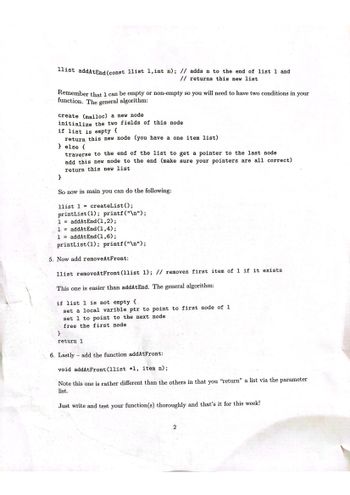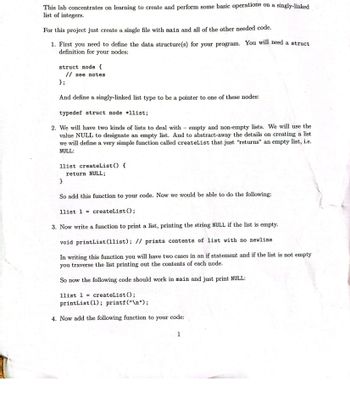This lab concentrates on learning to create and perform some basic operations on a singly-linked list of integers. For this project just create a single file with main and all of the other needed code. 1. First you need to define the data structure(s) for your program. You will need a struct definition for your nodes: struct node { // see notes }; And define a singly-linked list type to be a pointer to one of these nodes: typedef struct node *llist; 2. We will have two kinds of lists to deal with empty and non-empty lists. We will use the value NULL to designate an empty list. And to abstract-away the details on creating a list we will define a very simple function called createList that just "returns" an empty list, i.e. NULL: llist createList() { return NULL; } So add this function to your code. Now we would be able to do the following: llist 1 createList(); 3. Now write a function to print a list, printing the string NULL if the list is empty. void printList (llist); // prints contents of list with no newline In writing this function you will have two cases in an if statement and if the list is not empty you traverse the list printing out the contents of each node. So now the following code should work in main and just print NULL: llist 1 createList(); printList (1); printf("\n");
This lab concentrates on learning to create and perform some basic operations on a singly-linked list of integers. For this project just create a single file with main and all of the other needed code. 1. First you need to define the data structure(s) for your program. You will need a struct definition for your nodes: struct node { // see notes }; And define a singly-linked list type to be a pointer to one of these nodes: typedef struct node *llist; 2. We will have two kinds of lists to deal with empty and non-empty lists. We will use the value NULL to designate an empty list. And to abstract-away the details on creating a list we will define a very simple function called createList that just "returns" an empty list, i.e. NULL: llist createList() { return NULL; } So add this function to your code. Now we would be able to do the following: llist 1 createList(); 3. Now write a function to print a list, printing the string NULL if the list is empty. void printList (llist); // prints contents of list with no newline In writing this function you will have two cases in an if statement and if the list is not empty you traverse the list printing out the contents of each node. So now the following code should work in main and just print NULL: llist 1 createList(); printList (1); printf("\n");
Database System Concepts
7th Edition
ISBN:9780078022159
Author:Abraham Silberschatz Professor, Henry F. Korth, S. Sudarshan
Publisher:Abraham Silberschatz Professor, Henry F. Korth, S. Sudarshan
Chapter1: Introduction
Section: Chapter Questions
Problem 1PE
Related questions
Question
Linked lists. Please help, the program is in C language

Transcribed Image Text:### Linked List Operations in C
#### Function: `addAtEnd`
```c
llist addAtEnd(const llist l, int n);
// Adds n to the end of list l and returns this new list
```
- **Algorithm Overview**:
1. Create (malloc) a new node.
2. Initialize the two fields of this node.
3. If the list is empty:
- Return this new node (you have a one-item list).
4. Otherwise:
- Traverse to the end of the list to get a pointer to the last node.
- Add this new node to the end (ensure all pointers are correct).
- Return this new list.
- **Example in `main`**:
```c
llist l = createList();
printList(l); printf("\n");
l = addAtEnd(l, 2);
l = addAtEnd(l, 4);
l = addAtEnd(l, 6);
printList(l); printf("\n");
```
#### Function: `removeAtFront`
```c
llist removeAtFront(llist l);
// Removes the first item of l if it exists
```
- **Algorithm Overview**:
1. If list l is not empty:
- Set a local variable pointer to the first node of l.
- Set l to point to the next node.
- Free the first node.
2. Return l.
#### Function: `addAtFront`
```c
void addAtFront(llist *l, item n);
```
- Note this function is different as it "returns" a list via the parameter list.
#### Instructions:
- Thoroughly write and test your functions.
- That's it for this week!

Transcribed Image Text:# Basic Operations on a Singly-Linked List of Integers
This lab focuses on learning to create and perform some basic operations on a singly-linked list of integers.
## Project Instructions
To complete this project, create a single file with `main` and all necessary code.
### Steps:
1. **Define Data Structures**
First, define the data structure(s) for your program. You will need a `struct` definition for your nodes:
```c
struct node {
// see notes
};
```
Define a singly-linked list type to be a pointer to one of these nodes:
```c
typedef struct node *llist;
```
2. **Create an Empty List**
We will handle two kinds of lists: empty and non-empty lists. Use the value `NULL` to designate an empty list. To abstract away the details of list creation, define a simple function called `createList` that returns an empty list, i.e., `NULL`:
```c
llist createList() {
return NULL;
}
```
Add this function to your code. You can now initialize a list as follows:
```c
llist l = createList();
```
3. **Print the List**
Write a function to print a list. This function will print "NULL" if the list is empty:
```c
void printList(llist); // prints contents of list with no newline
```
In this function, include an `if` statement to handle the two cases: empty and non-empty list. Traverse the list to print each node's contents.
The following code should work in `main`, printing just "NULL":
```c
llist l = createList();
printList(l); printf("\n");
```
4. **Add More Functions**
Extend your code with additional functions as needed.
This guide will help you create and manipulate a singly-linked list, focusing on the creation and simple handling of linked lists in C.
Expert Solution
Step 1
Answer:
Our guidelines is answer the first three question from the first question .so we have done first three question
Trending now
This is a popular solution!
Step by step
Solved in 3 steps with 1 images

Follow-up Questions
Read through expert solutions to related follow-up questions below.
Follow-up Question
Please answer the remaining questions. This is supposed to be one question with multiple parts

Transcribed Image Text:The document provides a tutorial on implementing linked list functions in C. It explains the algorithms for adding and removing elements from a linked list and how to apply these in a main function.
### Adding a Node to the End of a List
Function: `llist addAtEnd(const llist l, int n);`
- **Description**: Adds the integer `n` to the end of list `l` and returns the updated list.
- **Algorithm**:
- Create (using `malloc`) a new node.
- Initialize the two fields of this node.
- If the list `l` is empty:
- Return this new node as the single-element list.
- Otherwise:
- Traverse to the end of the list to get a pointer to the last node.
- Add this new node to the end.
- Return the new list.
- **Example in Main**:
```c
llist l = createList();
printList(l); printf("\n");
l = addAtEnd(l, 2);
l = addAtEnd(l, 4);
l = addAtEnd(l, 6);
printList(l); printf("\n");
```
### Removing the First Node
Function: `llist removeAtFront(llist l);`
- **Description**: Removes the first item of list `l` if it exists.
- **Algorithm**:
- If list `l` is not empty:
- Set a local variable `ptr` to point to the first node.
- Set `l` to point to the next node.
- Free the first node.
- Return the updated list.
### Adding a Node to the Front
Function: `void addAtFront(llist *l, item n);`
- **Description**: Adds an item to the front of the list. Note that it "returns" the list via the parameter, as it updates the pointer.
### Final Note
The document ends with a prompt to thoroughly write and test these functions, suggesting this as an exercise or assignment to deepen understanding.

Transcribed Image Text:**Introduction to Singly-Linked Lists: A Beginner's Guide**
This lab focuses on creating and performing basic operations on a singly-linked list of integers. Follow the steps below to learn how to implement and manage a singly-linked list.
### Steps to Implement a Singly-Linked List
1. **Define the Data Structure**
- Start by defining the structure(s) required. You'll need a `struct` definition for the nodes:
```c
struct node {
// see notes
};
```
- Define a singly-linked list type as a pointer to these nodes:
```c
typedef struct node *llist;
```
2. **Create an Empty List**
- Differentiate between empty and non-empty lists. Use the value `NULL` to signify an empty list. Create a simple function, `createList`, that returns an empty list, i.e., `NULL`:
```c
llist createList() {
return NULL;
}
```
- Add this function to your code. It allows you to initialize a list as follows:
```c
llist l = createList();
```
3. **Print the List**
- Write a function to print the list; if the list is empty, it prints the string `NULL`.
```c
void printList(llist); // prints contents of list without newline
```
- This function should have two cases within an `if` statement. If not empty, iterate through the list and print the contents of each node.
- For example, in your main, the following code would print `NULL`:
```c
llist l = createList();
printList(l); printf("\n");
```
4. **Further Functions**
- Continue by adding further functions as required to manipulate the list.
This step-by-step guide covers the basic setup and operations for a singly-linked list, equipping you with foundational skills for working with data structures in programming.
Solution
Knowledge Booster
Learn more about
Need a deep-dive on the concept behind this application? Look no further. Learn more about this topic, computer-science and related others by exploring similar questions and additional content below.Recommended textbooks for you

Database System Concepts
Computer Science
ISBN:
9780078022159
Author:
Abraham Silberschatz Professor, Henry F. Korth, S. Sudarshan
Publisher:
McGraw-Hill Education

Starting Out with Python (4th Edition)
Computer Science
ISBN:
9780134444321
Author:
Tony Gaddis
Publisher:
PEARSON

Digital Fundamentals (11th Edition)
Computer Science
ISBN:
9780132737968
Author:
Thomas L. Floyd
Publisher:
PEARSON

Database System Concepts
Computer Science
ISBN:
9780078022159
Author:
Abraham Silberschatz Professor, Henry F. Korth, S. Sudarshan
Publisher:
McGraw-Hill Education

Starting Out with Python (4th Edition)
Computer Science
ISBN:
9780134444321
Author:
Tony Gaddis
Publisher:
PEARSON

Digital Fundamentals (11th Edition)
Computer Science
ISBN:
9780132737968
Author:
Thomas L. Floyd
Publisher:
PEARSON

C How to Program (8th Edition)
Computer Science
ISBN:
9780133976892
Author:
Paul J. Deitel, Harvey Deitel
Publisher:
PEARSON

Database Systems: Design, Implementation, & Manag…
Computer Science
ISBN:
9781337627900
Author:
Carlos Coronel, Steven Morris
Publisher:
Cengage Learning

Programmable Logic Controllers
Computer Science
ISBN:
9780073373843
Author:
Frank D. Petruzella
Publisher:
McGraw-Hill Education